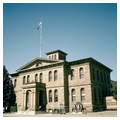You are here
Nevada State Museum (U.S. Mint)
Like many of the structures of the Capitol Complex, the Nevada State Museum building, erected as a U.S. mint, is constructed of local sandstone. Millions of dollars of gold and silver bullion from the Comstock Lode passed through its doors. The mint produced both ingots and coins. The rough-faced stone walls and simple, stocky appearance of the building presented a facade of security. Mullett, Supervising Architect of the Treasury from 1866 to 1874, advocated large scale in government buildings to emphasize permanence and solidity. The two-story building has both Classical Revival and Italianate elements, seen in the front and rear pediments, symmetrical five-bay facade, and prominent brackets lining the cornice. A central section containing the entrance projects toward Carson Street. The entrance itself is sheltered by a stone porch with segmental-arched openings supported by wide piers with pairs of Tuscan pilasters. Both the porch and the cupola surmounting the hipped roof are constructed of smooth-faced sandstone to contrast with the rough walls of the main structure. In 1878 a one-story rear wing was added, followed by a second story in 1881.
The building served as the mint until 1893, when it became a federal office building. In 1939 the state of Nevada purchased the building for use as a museum. In 1959 it added a small wing to the southwest for exhibition space, and, in 1971, demolished the late nineteenth-century wing to make way for a boxy replacement with tall arched windows. The insensitive addition does not do justice to the venerable building.
Writing Credits
If SAH Archipedia has been useful to you, please consider supporting it.
SAH Archipedia tells the story of the United States through its buildings, landscapes, and cities. This freely available resource empowers the public with authoritative knowledge that deepens their understanding and appreciation of the built environment. But the Society of Architectural Historians, which created SAH Archipedia with University of Virginia Press, needs your support to maintain the high-caliber research, writing, photography, cartography, editing, design, and programming that make SAH Archipedia a trusted online resource available to all who value the history of place, heritage tourism, and learning.




